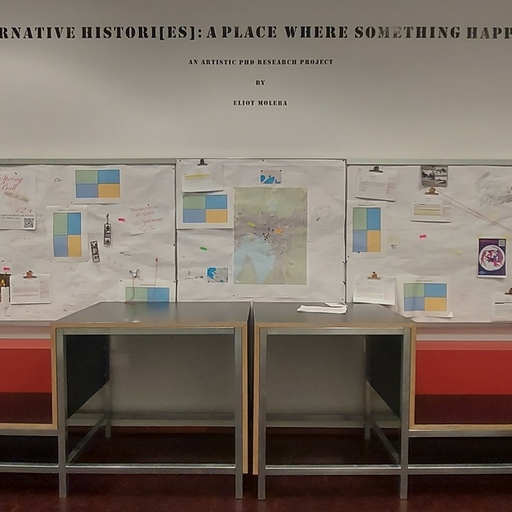Alternative Histori[es]: A Place Where Something Happened
Stipendiat Eliot Molebas doktorgradsprosjekt
Vitenskapelig sammendrag
This artistic research project focuses on narrative accounts of Norwegians who self-identify with a multicultural and/or immigration background(s) to explore how their (hi)stories can be woven into the tapestry of the contemporary Norwegian public memory and story. I set out to interview and collect their narrative accounts, which must also be understood as oral (topical) histories, focusing on (hi)stories of their lived experiences, with a special interest in an event that happened in a public space and has been experienced as a meaningful or life-changing moment. Through a collaborative process, the oral (hi)stories were transformed and used to produce interactive monuments installed on the sites where the narrated events occurred.
One of the critical artistic challenges in the project was grappling with the question of how collaborators and the public can be empowered to actively shape and engage with artistic works, becoming co-collaborators themselves.
This artistic inquiry led to the development of monu(mo)ments, an artistic concept, and initiative dedicated to turning stories of Norways diversity into interactive, performative works of public art. The monu(mo)ments are not just symbols of collective memory but embody that very concept in how they themselves function. Through an interactive/participatory design, the public is invited to contribute their narratives, perspectives, and experiences, shaping the monu(mo)ments meaning and relevance. They invite the public to become co-creators of the narratives embedded within their communal spaces, fostering a sense of ownership and agency and blurring the boundaries between the artist(s) and the public, the past and the present.
The project strives to illuminate these narrators' untold oral (hi)stories by allowing them to take over public spaces and infuse them with gripping personal narratives to shift how we read those places and (re)negotiate their past/meaning. This is to create an alternative history dedicated to writing and inscribing these voices into public spaces and our broader collective imagination.
Other artistic results include a live-action role-playing game (LARP). Furthermore, the larp was modified to serve as a resource for educators, enabling them to address interconnected themes within their classrooms through immersive gameplay. It has been performed in schools, festivals, and conferences in Norway, Austria, and Denmark.
Overall, by creating artistic works that (re)imagine public memory as a dynamic and interactive process, this artistic research project foregrounds and contributes to the ongoing efforts to capture and reflect Norway's multicultural reality and identity.
Fakta om prosjektet
| Prosjekttittel | Alternative Histori[es]: A Place Where Something Happened |
|---|---|
| Prosjektleder |
|
| Startdato | |
| Sluttdato | |
| Prosjektstatus | Avsluttet |
| Avdeling | Teaterhøgskolen |
| Resultater |
|
